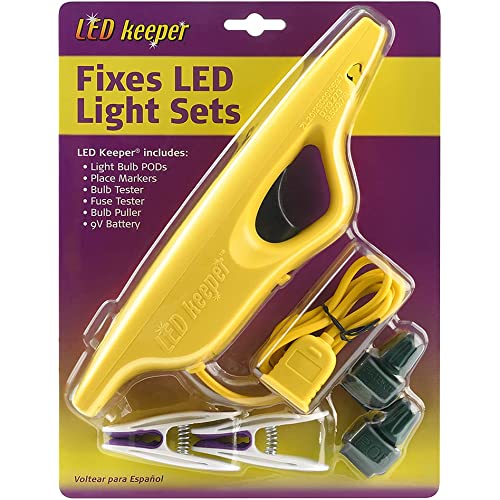

LED Keeper® - LED Holiday Light Set Repair Tool
-

Arlan D. Leeds
Greater than one weekI had one fairly long LED icicle string that had a 4ft section go dark last year. When I started putting up my lights this year, that section was still out. I decided to try this tester and within about 5 minutes I had isolated the problem down to a single LED. I replaced the LED and the section came back to life. It definitely saved me from having to buy a new string. I would prefer a pistol grip for holding it and squeezing the trigger... I felt holding this in my hand somewhat awkward. I will add that I am an Engineer who spent most of my career fixing computers, so the logical process of elimination required to use this was very intuitive for me. You have to keep track of what works and what doesnt while youre testing so you can gradually narrow it down to the failed LED(s)/socket(s). For me, it was absolutely worth the money.
-

James Shumate
> 3 daythis took a few minutes and with already socketed LED it went quickly. Read for next year. C9 LED outdoor ready. I like it. Thank you.
-

nobody
> 3 dayExtremely disappointed in this product. Theres so much about its design and function that it makes no sense. Its to the point Im confused about all the positive reviews. Ill go down a list of what is wrong with the thing: - the instructions are terrible. I had to find the official video guide online to figure out how to use it - a string of lights must be plugged into the device meaning the lights will be lit by a 9 volt battery. The battery just didnt provide enough juice to light up the LEDs well enough to tell if the light is bad or dim (because its so dim it doesnt appear to light up) - if the strings wires are twisted pretty tightly (like theyre supposed to) its difficult to slip the wire into the testing hook. and this is the biggest ????? of them all: - the LED keeper cuts through the wires insulation to make a complete electrical circuit which is a stupid and inconvenient method of detecting bad lights. Ultimately what this is going to do is kill the string of lights faster by allowing the copper wire to be exposed to the elements, especially if the string the LED keeper is used to fix is going to be used outside. The LED keeper wasnt able to help me find any bad lights at all. Seriously, youre better off buying a contactless voltage detector and watching a youtube video tell you how to use one to detect bad lights on a string of Christmas lights. Its much cheaper and faster than the LED keeper. To make matters worse, what Amazon shipped me was either used or returned and definitely not new.
-

Craig kirk
19-04-2025Works great, there were no instructions so I searched You Tube (how to fix LED Christmas lights) a video popped up with this tool. i watched it twice. I had a 300 string led set I purchased last year because I thought they lasted longer but low and behold I put them up and just like every Christmas some did not work. In about 15 min. I fixed my string which had 3 bulbs out. I then went outside and fixed the C6 led lights on my Christmas tree in about 5 minutes. I read other reviews who said the trigger was hard to squeeze and sometimes you had to pinch the wire a few times. I had none of those problems. Prior to buying it would have cost me $52 to buy new lights. So for $25 bucks which is a week of Dunkin Doughnut coffees I purchased the tool. Well worth the money. All my lights work now and a total of 20 minutes was spent. I highly recommend the product and look forward to more lights going out so I can fix them. JUST BUY IT!!!!!!
-

SweetStephy1
Greater than one weekSee,title
-

Jodie Gibson
> 3 dayI have had the Light Pro for incandescent Christmas lights for years and it works great. Its quick and easy. The LED keeper is much harder to use and when you find the problem their correction is not ideal. I watched all the videos and they made it look easy, but its not as easy as it looks. I was a general contractor for over 45 years and know my way around electricity. I bought this unit thinking it was going to be easy. It maybe for you, but it wasnt for me.
-

Meg Mac
> 3 dayI watched a video on YouTube and saw the simple process for fixing the lights. I had 3 sets that were partially out and 1 completely out. The partially out ones were easy fixes; the completely out set was harder but thats because there were 8 bad bulbs! Great product!
-

CDK
Greater than one weekThere is no way I would have found the four to 6 bad leds in each string. This product is worth every penny. Dont throw out those strings that dont light, spend the $25 and fix em. You can purchase spare diodes on Amazon as well (cheap). Watch you tube videos and understand how it works and youll be a pro in no time. Definitely recommend this.
-

Bernie84
> 3 dayThe first time I used the tool I repaired four 25 ft light strands in about 25 minutes, saving me more than the cost of the LED Keeper! The tool is easy to use and I recommend watching one of the videos on Youtube starting out. After your first repair, you’ll feel like a pro and be able to fix an unlit string in minutes. In addition to finding the bad bulb, the tool has a bulb remover to save your fingernails, a bulb tester, and also a fuse tester built in! Great value for the money.
-

Frank Rogers
> 3 dayJust repaired 8 strings of GE lights that I thought were goners. Some strings had a bad section, some strings only had a short good section. Looked like a nightmare, but wifey said, Lets at least try that tool. Fair enough. Plug a set into an outlet. Mark the start point and end point of the section that wont light. Unplug from wall and plug into the tool. Now, lets say you identified a dark section of 30 lights. Go to the 15th light and squeeze the tester on the wire to that light. In most cases, either lights 1-15 will light, or lights 16 through 30 will light. Lets say lights 1-15 light up. Excellent. Now you KNOW that your naughty LED is hiding among lights 16-30. Time to test again. Where? Split the difference: which in this hypothetical scenario would be around light 23. Squeeze the tester on the wire going into light 23 and... the lights before it or the lights after it will light up! Aha. So your naughty light is hiding among the dark lights... and all you need to do is keep narrowing it down until you hit it. Sometimes you find it quickly, sometimes it takes a little longer. Some of the strings I fixed had 4 or 5 bad lights - which meant doing this process several times, each time on a different section. But I look at it this way: $30 for a tool that just saved me 8x$20=$160 worth of lights. NOTE!! What does a GOOD light look like vs a BAD light? The bad bulb often (not always) has a bad wire on it. To help give you and idea what I mean, take a look at the pictures: One of the wires has burned off of the bad LED. Compare that to the good LED in the other picture: two wires, both intact. Every once in a while (1 out of 15 in my case) you will find a bad LED that looks perfectly good. Fortunately, the tool has a little socket on it so you can test good looking bulbs.
